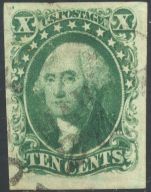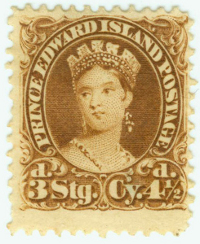
Discussion - Member to Member Sales - Research Center

Discussion - Member to Member Sales - Research Center


I believe this to be a faked cancellation.
Compare to this item:

What I notice about the upper image, compared to the lower image:
- the "5" is skewed, and not straight and upright like the bottom cancellation. All three characters ("C", "5" and "1" are mis-shaped.
- there should be two distinct, narrow lines on either side of the "C51". These lines in the top cancellation are not as distinct and are wider.
- A general smudginess in the top cancellation that is not typical of these strikes. The edges and ends of the horizontal lines are not crisp.
In several months, looking at hundreds of examples of this cancellation, this is the first one that I've seen that I thought looked faked.
Whaddaya think?
Thanks,
-Paul

Login to Like
this post
While I can see the distinct differences between the two postmarks, I would be interested to know what advantage you think there would have been for one of these to be faked.
Although I don't have a catalogue at hand, nor am I a GB collector, I perhaps would guess that a mint copy of the six pence would be higher valued if left uncancelled.
Could there be another possibility perhaps? Such as a second cancellator type, used in a busy post office? This does occur in numerous British/Commonwealth post offices.

Login to Like
this post
Well, having searched these cancellations for a few months, I can tell you that nice examples are commonly offered for anywhere from $40 to $250, depending on cancel centering, stamp centering, and the stamp issue they're on. I'm not a GB collector, but I would guess that that foreign cancellations typically double the value of the item, just based on rarity, some more than others. For example, Malta and Gibraltar are relatively (and understandably) more common than the Caribbean ones.
All that said, 1988 Scott values a mint #60 (6p) at $700, used at $25. So, I see your point. Makes this item all the more curious, to me.
Thanks for prompting me to crack open the catalog! It's a good point you make.
Like I said, after looking at hundreds of examples of the C51 cancellation, and being fully aware of the (3) types that were used, the one on the 6p that I pictured stands out as atypical.
By the way, there were several other offerings by this seller that looked similarly suspect...
Thanks,
-Paul

Login to Like
this post
I must admit that I missed the word 'abroad' in your topic title. I guess I would have noticed better if the specific country had been mentioned. Hence my comments about mint valuation over used.
This does now give a different slant to your discovery. So which country used 'C51'?

Login to Like
this post
Actually the cancellation in question above appears to have characteristics similar to the "C60" cancellation in you earlier thread.
https://stamporama.com/discboard/disc_main.php?action=20&id=19620#144965

Login to Like
this post
My 'Numerical Cancellations of the British Empire' list C51 as the city of Muzaffarnagar in northern India.

Login to Like
this post
C51 is Danish West Indies.
http://www.gbps.org.uk/information/po-numbers/overseas.php
Above is a good link to cancellations of Great Britain stamps.
Cheers!
Wine

Login to Like
this post
I stand corrected India town is C-51; C51 is St. Thomas, Danish West Indies.

1 Member
likes this post.
Login to Like.
If I can throw a spanner in the works. It looks to me like sloppy use of the canceller.A soft envelope, perhaps or cancelling not on a flat surface or even just a slight drag on application. This would make a direct comparison with known example difficult. Even today we see multiple "bad" cancellations.
If it is a forgery it is clumsy one - hence the query in the first place. I am sure that a half-competent counterfeiter would make a better job of it.
.....just a thought.

Login to Like
this post
Thanks everyone, for the fine responses!
To respond directly to webpaper, in this realm, it is important to compare apples to apples. There were (at least) two distinct versions of the letter-numeral device, and the post he refers to shows one of each. The differences between the two are huge.
And, I had thought about malcolm's point regarding technique. It just seems to me that the deviations on my suspect image are so many...
As to variation between cancelling devices, if there were several devices (which seems unlikely in a low-volume location like St Thomas), I guess I would expect to be able to sort the cancellations accordingly. Like I said, I've looked at a lot of these, and that explanation is not very plausible, in my mind...
Again, thanks!
-Paul

Login to Like
this post
10:23:33am
Here's an item currently being offered on eBay:

I believe this to be a faked cancellation.
Compare to this item:

What I notice about the upper image, compared to the lower image:
- the "5" is skewed, and not straight and upright like the bottom cancellation. All three characters ("C", "5" and "1" are mis-shaped.
- there should be two distinct, narrow lines on either side of the "C51". These lines in the top cancellation are not as distinct and are wider.
- A general smudginess in the top cancellation that is not typical of these strikes. The edges and ends of the horizontal lines are not crisp.
In several months, looking at hundreds of examples of this cancellation, this is the first one that I've seen that I thought looked faked.
Whaddaya think?
Thanks,
-Paul

Login to Like
this post

re: GB used abroad: faked cancellation?
While I can see the distinct differences between the two postmarks, I would be interested to know what advantage you think there would have been for one of these to be faked.
Although I don't have a catalogue at hand, nor am I a GB collector, I perhaps would guess that a mint copy of the six pence would be higher valued if left uncancelled.
Could there be another possibility perhaps? Such as a second cancellator type, used in a busy post office? This does occur in numerous British/Commonwealth post offices.

Login to Like
this post
01:41:06pm
re: GB used abroad: faked cancellation?
Well, having searched these cancellations for a few months, I can tell you that nice examples are commonly offered for anywhere from $40 to $250, depending on cancel centering, stamp centering, and the stamp issue they're on. I'm not a GB collector, but I would guess that that foreign cancellations typically double the value of the item, just based on rarity, some more than others. For example, Malta and Gibraltar are relatively (and understandably) more common than the Caribbean ones.
All that said, 1988 Scott values a mint #60 (6p) at $700, used at $25. So, I see your point. Makes this item all the more curious, to me.
Thanks for prompting me to crack open the catalog! It's a good point you make.
Like I said, after looking at hundreds of examples of the C51 cancellation, and being fully aware of the (3) types that were used, the one on the 6p that I pictured stands out as atypical.
By the way, there were several other offerings by this seller that looked similarly suspect...
Thanks,
-Paul

Login to Like
this post

re: GB used abroad: faked cancellation?
I must admit that I missed the word 'abroad' in your topic title. I guess I would have noticed better if the specific country had been mentioned. Hence my comments about mint valuation over used.
This does now give a different slant to your discovery. So which country used 'C51'?

Login to Like
this post

re: GB used abroad: faked cancellation?
Actually the cancellation in question above appears to have characteristics similar to the "C60" cancellation in you earlier thread.
https://stamporama.com/discboard/disc_main.php?action=20&id=19620#144965

Login to Like
this post

re: GB used abroad: faked cancellation?
My 'Numerical Cancellations of the British Empire' list C51 as the city of Muzaffarnagar in northern India.

Login to Like
this post

re: GB used abroad: faked cancellation?
C51 is Danish West Indies.
http://www.gbps.org.uk/information/po-numbers/overseas.php
Above is a good link to cancellations of Great Britain stamps.
Cheers!
Wine

Login to Like
this post

re: GB used abroad: faked cancellation?
I stand corrected India town is C-51; C51 is St. Thomas, Danish West Indies.

1 Member
likes this post.
Login to Like.
04:06:27am
re: GB used abroad: faked cancellation?
If I can throw a spanner in the works. It looks to me like sloppy use of the canceller.A soft envelope, perhaps or cancelling not on a flat surface or even just a slight drag on application. This would make a direct comparison with known example difficult. Even today we see multiple "bad" cancellations.
If it is a forgery it is clumsy one - hence the query in the first place. I am sure that a half-competent counterfeiter would make a better job of it.
.....just a thought.

Login to Like
this post
01:08:00pm
re: GB used abroad: faked cancellation?
Thanks everyone, for the fine responses!
To respond directly to webpaper, in this realm, it is important to compare apples to apples. There were (at least) two distinct versions of the letter-numeral device, and the post he refers to shows one of each. The differences between the two are huge.
And, I had thought about malcolm's point regarding technique. It just seems to me that the deviations on my suspect image are so many...
As to variation between cancelling devices, if there were several devices (which seems unlikely in a low-volume location like St Thomas), I guess I would expect to be able to sort the cancellations accordingly. Like I said, I've looked at a lot of these, and that explanation is not very plausible, in my mind...
Again, thanks!
-Paul

Login to Like
this post

